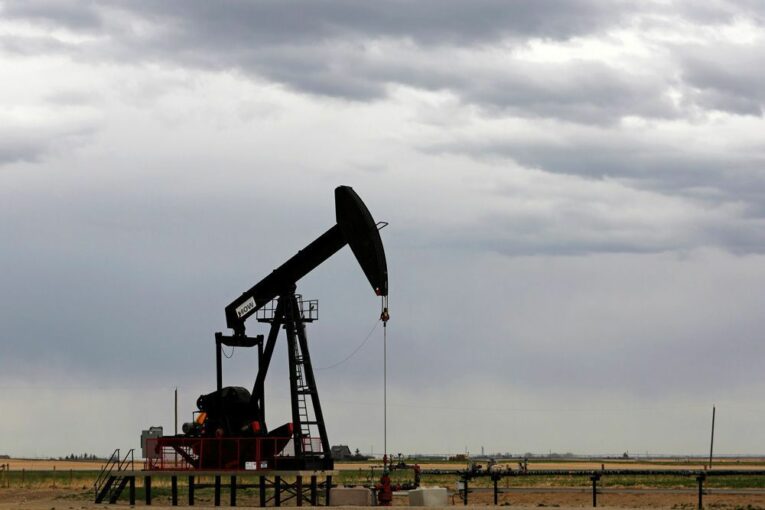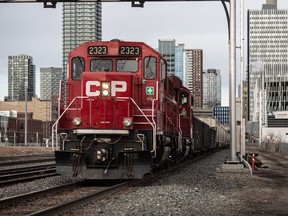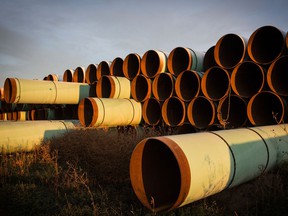
There aren’t many years when Alberta sees not one, but two corporate takeovers that top $25 billion.
Yet, a pair of high-flying deals — Canadian Pacific Railway defeating its rival to buy a U.S. railway, and Shaw Communications agreeing to a friendly takeover offer by Rogers Communications — couldn’t budge their way into the top spot of Alberta’s biggest business stories of the year.
The defibrillation of Canada’s oil and gas sector after a heart-stopping 2020, the impact of the pandemic on businesses — along with the thorny debate over vaccine passports — and a growing slate of energy transition projects head up the Calgary Herald’s Top 10 Business Stories of 2021.
Other pivotal events, including the death of the Keystone XL pipeline and the rise of Alberta’s tech sector, also grabbed headlines over the past 12 months.
But the revival of Alberta’s largest industry was a growing theme with far-reaching ramifications for the province in 2021, earning it top spot.
“The rebound in commodity prices … has given Alberta a sense there’s some bright light at the end of the tunnel,” says Adam Legge, president of the Business Council of Alberta.
“It is part of the whole recovery and it will set the pace and the tone for next year,” adds Charles St-Arnaud, chief economist with Alberta Central.
- Oilpatch revival
The Canadian oil and gas sector stared into the abyss in 2020 as commodity prices tanked, but 2021 proved the resiliency of the industry.
Oil prices began the year below US$48 a barrel, dealing a weak hand to companies that had piled on massive amounts of debt during the pandemic.
Yet, the reopening of the global economy, renewed discipline by OPEC+ and chronic underinvestment by the sector fuelled higher oil prices.
By October, oil roared past $80 a barrel, prompting analysts to muse about the return of $100 crude.
Concerns over the Omicron variant deflated some of the exuberance in December, but Canadian companies enjoyed surging profits.
Four of the country’s largest oilsands producers pumped out a combined $10.4 billion in net earnings through the first nine months of the year, compared with $8.3 billion of red ink in the same period in 2020.
Natural gas prices have also rallied this year, while drilling levels have picked up.
With all of the excess cash, companies are increasing (or bringing back) dividends, buying back their shares and paying down debt.
“Industry is responding in a much more prudent fashion with their capital, not putting it back in the ground,” says Martin Pelletier, a portfolio manager at Wellington-Altus Private Counsel in Calgary.
“That’s the new model.”
The industry increased output in Alberta, hitting record levels in October; production values have also hit all-time highs since the middle of the year, notes St-Arnaud.
- Pandemic woes and vaccine passports
The prospect of widespread vaccination held out great hope for hard-hit Alberta businesses after the pandemic forced the closure of thousands of companies in 2020.
Vaccines did arrive, but the back-and-forth of reopenings and closures continued to sideswipe businesses, hitting restaurants, hotels and those in the tourism sectors particularly hard.
“We obviously have been on a bit of a yo-yo,” says Legge.
In June, the Kenney government announced the province would be open for summer, with all restrictions dropped in time for Canada Day, allowing movie theatres, restaurants, gyms, bars and retailers to open without capacity limits.
It wouldn’t last.
The fourth wave of COVID-19 surged in late summer and early fall, sending hospitalization rates skyrocketing and prompting more restrictions.
In the fall, Alberta introduced a proof of vaccination program for patrons to go into places such as restaurants or bars. By November, Albertans were required to show a digital QR code.

Meanwhile, private companies grappled with the issue of making vaccination mandatory for staff.
“I had many an executive say they’d never dealt with a more challenging and complex issue in their careers,” Legge says.
- Energy transition at hyper-speed
While the oilpatch staged a comeback in 2021, efforts to decarbonize, invest in clean-energy developments and adopt net-zero emissions targets moved at lightning speed.
Even before the COP26 climate summit took place in November, a flurry of announcements in Alberta underscored the dizzying pace of the transformation.
In June, Pennsylvania-based Air Products announced plans to build a new $1.3-billion net-zero hydrogen production and liquefaction complex in northeast Edmonton.
On the same day, five major oilsands producers formed a new alliance to work together to reach net-zero emissions from their operations by 2050.
“This is a watershed event,” declared MEG Energy CEO Derek Evans.
The group is seeking federal incentives for carbon capture, utilization and storage (CCUS) developments, with the province requesting more than $30 billion in such assistance over a decade.
Other innovative projects and partnerships were pitched by companies including ATCO and Suncor Energy; Enbridge and Capital Power; Shell Canada and Mitsubishi; and TC Energy and Pembina Pipeline.
In October, Dow Inc. proposed building the “world’s first net-zero carbon emissions” ethylene cracker and derivatives complex at Fort Saskatchewan, potentially costing $10 billion to complete.
“A year ago, would anybody have predicted we’d be looking at these kinds of agreements and initiatives?” says Calgary Chamber of Commerce CEO Deborah Yedlin.
“We were talking about the need for it, but I don’t think anyone ever expected the critical mass to all of a sudden be created in the last 12 months.”
Renewable energy projects also moved forward. Large corporations — including Amazon and Labatt Breweries of Canada — signed partnership deals to acquire power from wind and solar developments in Alberta’s deregulated electricity market.
“It tells us this is main street, it’s not fringe,” says Bob Schulz, a professor at the University of Calgary’s Haskayne School of Business.
- CP outduels CN for U.S. railway
In March, Canadian Pacific Railway upended the North American rail industry with a bold proposal: a friendly US$25-billion deal to acquire the smallest major railway in the United States, Kansas City Southern (KCS).
It bet that a combination of the two smallest Class 1 railways in the two countries would get the green light from U.S. regulators.
The union of the two companies, with no overlap between their networks, would extend CP’s reach south to the U.S. Gulf Coast and into Mexico, creating a company with almost 20,000 employees, headquartered in Calgary.

Rival Canadian National Railway soon wanted in on the action, launching a $30-billion hostile offer to break up the marriage.
“It’s fantasy money. It is fool’s gold,” replied CP’s chief executive Keith Creel.
CN’s higher bid was stopped in its tracks after the U.S. Surface Transportation Board rejected CN’s use of a voting trust in connection with its bid for KCS — something the regulator had granted the Calgary-based company.
Shareholders with CP and KCS approved the $31-billion union (including debt) in December with a final review by U.S. regulators expected to conclude in 2022.
- Tech traction
It wasn’t that long ago that the technology sector was seen as a small cog in Alberta’s economic engine.
In 2021, the cog began a key component for job creation.
Homegrown firms such as Benevity, Jobber, Symend and Neo Financial added staff, raised capital and gained prominence.
Several announcements defined the industry’s upward trajectory.

In March, India-based information technology giant Infosys announced it would bring 500 new jobs to Calgary.
Bangalore-based Mphasis, which provides IT outsourcing services, said in June it would establish a Canadian headquarters in Calgary, bringing up to 1,000 jobs to the city.
Amazon Web Services revealed in November it will build a new cloud-computing hub in the city, creating hundreds of jobs and bringing $4 billion of investment.
“I was already getting excited about the startup community because there’s just so much happening,” says Benevity CEO Kelly Schmitt.
“What got added to that in 2021 are some larger companies choosing to have a footprint here.”
- Keystone XL dies, Line 3 opens, Line 5 under pressure
The political battles surrounding Canadian pipelines continued in 2021, highlighted by the death of Keystone XL.
In January, on his first day in office, U.S. President Joe Biden cancelled the permit for the cross-border oil pipeline by TC Energy, citing climate concerns.
First proposed in 2008, construction of Keystone XL finally began last year after the Kenney government agreed to invest in the project. The province says its financial exposure in the now-defunct development sits at $1.3 billion.

While Keystone XL perished, Enbridge finally finished construction in the U.S. on its Line 3 replacement project.
And the political tussle over Enbridge’s Line 5 project escalated after Michigan Gov. Gretchen Whitmer ordered the Calgary-based company to stop operating the oil pipeline, which runs under the Straits of Mackinac, by May.
It prompted a legal fight and Ottawa weighed into the fracas, seeking to invoke a 1977 pipeline treaty between Canada and the U.S., and the lawsuits continue.
- Alberta’s economy bounces back
The pandemic and oil-price crash last year ignited the worst recession in Alberta’s modern history, an almost eight per cent contraction in the economy.
But higher commodity prices, the reopening of businesses during the pandemic, and a revival of the housing market and other sectors led to a rebound.
The province pegged GDP growth at 6.1 per cent for the year, accompanied by a five per cent increase in employment. However, inflation also reared its head, sitting above four per cent since August, while supply chain issues surfaced during the year.
A surge in energy royalties and income tax revenue saw the projected provincial deficit shrink to $5.8 billion from a forecast of more than $18 billion in the February budget.
“This is one of the fastest recoveries from any recession we’ve had,” says St-Arnaud.
- Rogers buys Shaw
In March, Toronto-based Rogers Communications unveiled a surprising $26-billion deal to purchase Shaw Communications, bringing together two industry giants in the country.
The deal marks the end of Calgary-based Shaw, which was founded by JR Shaw in 1966, while redrawing the country’s wireless sector.
The two companies promised the takeover would lead to a net increase of 1,800 jobs in Alberta.
The acquisition must still receive regulatory approval — concerns have focused on the deal’s impact on Canadian wireless prices — while Rogers has been dealing with a high-profile family feud over the company’s leadership this fall.
- Air turbulence gives way to take-off
The pandemic disrupted air travel around the country last year, but as more Canadians were vaccinated, the industry witnessed a return of passengers to airports in 2021.
The Calgary Airport Authority, which saw its traffic plunge by 95 per cent in April 2020, experienced a partial recovery through the summer and fall this year, although the new Omicron variant led Ottawa to warn Canadians against non-essential travel in mid-December.

In August, as more people began to book flights, WestJet rolled out a plan to recoup 11 years of historic growth within six months, getting back to its 2013 levels. Staffing at the company, which dropped during the pandemic below 5,000 active employees, now sits above 7,900.
In November, the Calgary-based company formerly known as Enerjet was launched as new ultra-low-cost carrier Lynx Air, which will begin flying in 2022. And Edmonton-based Flair Airlines grew throughout the year, saying it intends to expand the company’s fleet to 30 planes by mid-2023.
- Oilpatch M&A
Consolidation in the Canadian energy sector expanded in 2021, with Brookfield Infrastructure Partners in August winning an $8.6-billion hostile takeover bid for Calgary-based Inter Pipeline, topping a competing friendly offer from Pembina Pipeline. And in February, ARC Resources acquired Seven Generations Energy for $5 billion.
You can read more of the news on source
